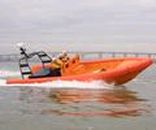Chiswick Lifeboat
Related links
|
CHISWICK LIFEBOAT STATION OPENS
The station will be run by Wayne Bellamy who is a graduate of the Canadian Coastguard's rigid hull inflatable operator training school and has navigation, search and rescue, marine fire fighting and incident management experience. He has served as coxswain and crew on a variety of rescue craft including catamarans and hovercraft. During his time with Canadian Airlines at Heathrow, he developed an emergency response plan and a VIP concierge programme for the airline and travelled the world training colleagues. The RNLI was approached by the Maritime and Coastguard Agency (MCA) to provide the rescue service as a result of the findings of the Thames Safety Inquiries into the collision between the pleasure cruiser, The Marchioness, and the dredger, Bowbelle, which resulted in the loss of 51 lives in 1989, leading to a demand to step up search and rescue cover on the river. The MCA will co-ordinate the rescue operation from a Port of London Authority operations room at the Thames Barrier. 'There are in excess of 100 incidents on the river each year and over 100,000 people use the Thames every day' says Michael Vlasto, RNLI operations director. 'By providing well trained and well equipped lifeboat crews and calling on 177 years of lifeboat experience, we can provide a dedicated search and rescue service for Londoners and those using the river.' The boats being used on the Thames are E class Tiger Marine fast response craft, capable of 40 knots. The RNLI and the MCA have started a London Underground poster campaign to get Londoners used to having a dedicated rescue service on the river aimed at getting them to Call 999 and ask for the London Coastguard. 'This is a new concept for Londoners and we have to get them used to raising the alarm in this way' says Michael Vlasto. 'We are confident that the co-ordinated approach between ourselves, the MCA and other agencies will help safeguard lives on the Thames.' |
